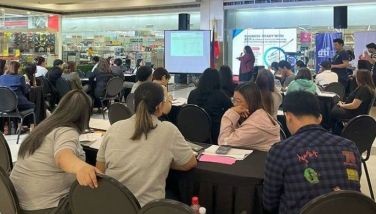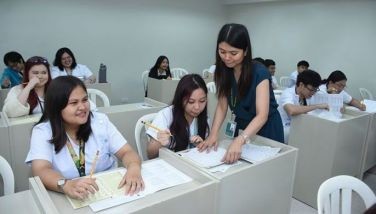Stagnation of rice sector threatens stability of Asia
May 11, 2004 | 12:00am
LOS BAÑOS, Laguna – Inadequate development in the rice sector continues to threaten the stability of Asia.
Rice farming remains a "poverty trap" in many Asian nations, mainly because of very small farm size. Adding to the misery of rice growers in the region is declining support for public rice research, one of the few proven avenues for improving the lives of rice farmers and consumers alike.
"The United Nations cannot hope to achieve its Millennium Development Goals – especially in such crucial areas as eradicating poverty and hunger – unless more is done to improve the livelihoods of poor rice farmers," asserted Dr. Ronald P. Cantrell, director general of the International Rice Research Institute (IRRI) based here.
He added that achieving at least two of the eight goals heavily depends on continued and strengthened research efforts to help farmers grow rice more efficiently, profitably, and sustainably. The two goals are eradicating extreme poverty and hunger and ensuring environmental sustainability.
Recent research has shown that in 1999, for every $1 million invested at IRRI, more than 800 rural poor in China and 15,000 rural poor in India were lifted above the poverty line. These poverty-reduction effects were even greater in earlier years.
Dr. Cantrell’s forum was a recent major conference on rice organized in Rome, Italy, by the Food and Agriculture Organization (FAO) of the United Nations. Titled "Rice in global markets and sustainable production systems," the conference marked the official launch of FAO activities for International Year of Rice (IYR) 2004.
The Philippines played a key role in the proclamation of 2004 as IYR by the UN. IRRI actively endorsed the proposal, which was supported by 42 other countries under the initiative of UN-FAO.
President Arroyo subsequently issued Proclamation 524 affirming the government’s commitment to the goals of IYR, namely: food security, reduction of poverty, environmental sustainability, and cultural heritage.
Dr. Cantrell, an internationally respected plant breeder, recalled that in the early years of the Green Revolution up to the early 1980s, the rice-producing nations of Asia enjoyed annual rice yield increases of 2.5 percent and production gains of more than three percent.
However, between the middle of the 1980s and the late 1990s. the rate of annual yield increase was nearly halved, and the rate of production increase fell even further.
"Many rural rice communites in Asia are growing increasingly restless, as productivity stagnation leaves them trapped in poverty and urgently needing new strategies and fresh ideas to help them improve their lives," the IRRI official noted. "They are waiting for new technologies to make them more productive and competitive and so lift them out of proverty."
Dr. Cantrell further stressed: "There is nothing more important to any country than its ability to feed itself. But if good security is one essential pillar of national security, another is rural development."
Poverty and a lack of opportunity – for education, livelihood, or simply the chance to lead a happy, healthy life – can foster instability. Desperate people forced to have home in search of work are susceptible to extremism; one of the Bali bombers had reportedly left his home village of Tenggulun, East Java, to seek work in Malaysia, where he was recruited by terrorists.
While this is a worst-case scenario, such reports should not be discounted, Dr. Cantrell said.
"The Asian rice industry is in trouble," he averred. "At a time of abundant supplies and record low prices, some may laugh at such a statement. But please allow me a few sentences to explain. Not only is the rice industry in Asia facing a crisis in the supply of such essential resources as land, labor and water, but – most important of all – many nations are finding it difficult to develop sustainable ways to provide decent livelihoods for rice farmers and consumers."
Dr. Cantrell said this huge challenge comes at a time of collapsing support for public rice research.
"While IRRI still has some very committed donors, there is no doubt that the institute could do a lot more if it had more support," he stressed.
For more than four decades, the research system that develops and delivers knowledge and new technologies to Asia’s rice farmers has been funded – and influenced – mostly by Western nations. But now, having achieved visible success, many of these generous donors are taking their resources elsewhere, such as Africa.
"For those talented Asian scientists who are already being prevented – some by unemployment – from using their knowledge to help the region’s farmers, this worrying decline in support of rice research has already reached a critical, if not a crisis, level," the IRRI official stated.
Fortunately, there is also some good news.
In the past 40 years, rice scientists and extensionists have built an impressive network all over Asia. In many nations, these scientists have as much expertise as their colleagues in the developed world. Asia’s rice scientists are world class and have achieved impressive results.
Summing up, Dr. Cantrell said that assuming that there are 200 million rice farmers in Asia, an investment of just 40 cents per farmer for each of the next 20 years would go a long way toward ensuring that they can earn to decent living sustainability supplying poor rice consumers with plentiful supplies of affordable nutritious rice.
The IRRI director general concluded: "Clearly, finding that much money won’t be easy, but if we agree that there is nothing more important in Asian than rice, then the challenge seems a little less daunting – especially during the International Year of Rice. Raising the funds we need will take time and careful thought, but the rewards will be there for all to see in a strong, vibrant rice industry that leads, rather than lafgs after, other regional industries in technological innovation."
Rice farming remains a "poverty trap" in many Asian nations, mainly because of very small farm size. Adding to the misery of rice growers in the region is declining support for public rice research, one of the few proven avenues for improving the lives of rice farmers and consumers alike.
"The United Nations cannot hope to achieve its Millennium Development Goals – especially in such crucial areas as eradicating poverty and hunger – unless more is done to improve the livelihoods of poor rice farmers," asserted Dr. Ronald P. Cantrell, director general of the International Rice Research Institute (IRRI) based here.
He added that achieving at least two of the eight goals heavily depends on continued and strengthened research efforts to help farmers grow rice more efficiently, profitably, and sustainably. The two goals are eradicating extreme poverty and hunger and ensuring environmental sustainability.
Recent research has shown that in 1999, for every $1 million invested at IRRI, more than 800 rural poor in China and 15,000 rural poor in India were lifted above the poverty line. These poverty-reduction effects were even greater in earlier years.
Dr. Cantrell’s forum was a recent major conference on rice organized in Rome, Italy, by the Food and Agriculture Organization (FAO) of the United Nations. Titled "Rice in global markets and sustainable production systems," the conference marked the official launch of FAO activities for International Year of Rice (IYR) 2004.
The Philippines played a key role in the proclamation of 2004 as IYR by the UN. IRRI actively endorsed the proposal, which was supported by 42 other countries under the initiative of UN-FAO.
President Arroyo subsequently issued Proclamation 524 affirming the government’s commitment to the goals of IYR, namely: food security, reduction of poverty, environmental sustainability, and cultural heritage.
Dr. Cantrell, an internationally respected plant breeder, recalled that in the early years of the Green Revolution up to the early 1980s, the rice-producing nations of Asia enjoyed annual rice yield increases of 2.5 percent and production gains of more than three percent.
However, between the middle of the 1980s and the late 1990s. the rate of annual yield increase was nearly halved, and the rate of production increase fell even further.
"Many rural rice communites in Asia are growing increasingly restless, as productivity stagnation leaves them trapped in poverty and urgently needing new strategies and fresh ideas to help them improve their lives," the IRRI official noted. "They are waiting for new technologies to make them more productive and competitive and so lift them out of proverty."
Dr. Cantrell further stressed: "There is nothing more important to any country than its ability to feed itself. But if good security is one essential pillar of national security, another is rural development."
Poverty and a lack of opportunity – for education, livelihood, or simply the chance to lead a happy, healthy life – can foster instability. Desperate people forced to have home in search of work are susceptible to extremism; one of the Bali bombers had reportedly left his home village of Tenggulun, East Java, to seek work in Malaysia, where he was recruited by terrorists.
While this is a worst-case scenario, such reports should not be discounted, Dr. Cantrell said.
"The Asian rice industry is in trouble," he averred. "At a time of abundant supplies and record low prices, some may laugh at such a statement. But please allow me a few sentences to explain. Not only is the rice industry in Asia facing a crisis in the supply of such essential resources as land, labor and water, but – most important of all – many nations are finding it difficult to develop sustainable ways to provide decent livelihoods for rice farmers and consumers."
Dr. Cantrell said this huge challenge comes at a time of collapsing support for public rice research.
"While IRRI still has some very committed donors, there is no doubt that the institute could do a lot more if it had more support," he stressed.
For more than four decades, the research system that develops and delivers knowledge and new technologies to Asia’s rice farmers has been funded – and influenced – mostly by Western nations. But now, having achieved visible success, many of these generous donors are taking their resources elsewhere, such as Africa.
"For those talented Asian scientists who are already being prevented – some by unemployment – from using their knowledge to help the region’s farmers, this worrying decline in support of rice research has already reached a critical, if not a crisis, level," the IRRI official stated.
Fortunately, there is also some good news.
In the past 40 years, rice scientists and extensionists have built an impressive network all over Asia. In many nations, these scientists have as much expertise as their colleagues in the developed world. Asia’s rice scientists are world class and have achieved impressive results.
Summing up, Dr. Cantrell said that assuming that there are 200 million rice farmers in Asia, an investment of just 40 cents per farmer for each of the next 20 years would go a long way toward ensuring that they can earn to decent living sustainability supplying poor rice consumers with plentiful supplies of affordable nutritious rice.
The IRRI director general concluded: "Clearly, finding that much money won’t be easy, but if we agree that there is nothing more important in Asian than rice, then the challenge seems a little less daunting – especially during the International Year of Rice. Raising the funds we need will take time and careful thought, but the rewards will be there for all to see in a strong, vibrant rice industry that leads, rather than lafgs after, other regional industries in technological innovation."
BrandSpace Articles
<
>
- Latest
- Trending
Trending
Latest
Trending
Latest
Recommended



























